Those owners of private houses who do not have the opportunity to connect to a centralized sewer line install an autonomous system in their home. Its presence is the key to comfortable living in your home. The sewerage system in a household is one of the elements of the water supply and sanitation system. It removes household waste in solid and liquid form. Thanks to a properly designed autonomous sewage system, contaminated fractions are processed, purified and subsequently converted into water that does not pose a health hazard.
Currently exists several types of autonomous sewers:
- storage type containers;
- cesspools;
- septic tanks with filtration fields;
- biological treatment system equipped with forced aeration.
If we talk about the sewerage system in general, it includes external and internal networks. The internal composition includes:
- fan pipe;
- riser;
- wiring to the toilet, bathroom and kitchen.
The external network of an autonomous sewerage system includes elements taken outside the building, and in addition a pipeline through which external pipes are connected to the internal system of the house. Also, such a system assumes availability of a treatment plant. This is usually a septic tank consisting of one or more chambers. The treatment plant also includes a storage station. As additional elements of the system, it may include a filtration field. Its presence ensures post-treatment of wastewater.
How to choose an autonomous sewer system for your home?
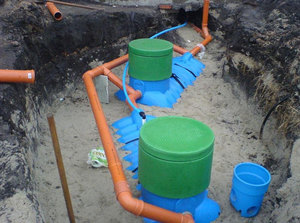 When choosing an autonomous sewer system for your home, you need to focus on the terrain parameters of the site. The following should be taken into account:
When choosing an autonomous sewer system for your home, you need to focus on the terrain parameters of the site. The following should be taken into account:
- climatic conditions;
- soil composition;
- the number of people living in the house.
Many people, having decided to install a sewer system in their home, often make a choice in favor of the Alta Bio or Uponor septic tank. When installing them, you must pay attention to the following points:
- they must have a volume of at least 6 cubic meters. m.;
- such a parameter as the depth should be at least 1.2 meters;
- there must be a gap of at least 30 cm between the water surface and the lid. This is necessary for the smooth removal of household waste;
- there must be a thermal insulation system.
If the sewage system in the house uses VOC- autonomous system, which in its shape resembles a monoblock and through which the biological method of cleaning household waste is used, it is necessary to provide such a system with a constant power supply.
The simplest sewerage method currently used is a cesspool with an overflow. You should only use it periodically, since you have to pump out accumulated wastewater from it quite often.
When choosing from the autonomous sewerage options that suits you, attention should be paid to the following points:
- ease of use;
- ease of station maintenance;
- no need to install additional pumping equipment;
- maintaining the system's functionality even during a power outage;
- complete absence of noise and unpleasant odors during operation;
- high structural strength and reliability;
- opportunity to perform installation work on your own;
- waste purification by 98%.
Do-it-yourself internal sewage system
 When installing internal sewerage, you should use pipes with a diameter of 110 mm. Currently, PVC pipes are most often used to create this system. In the kitchen and bathroom, pipes with a diameter of 50 mm are laid to drain used water and sewage.
When installing internal sewerage, you should use pipes with a diameter of 110 mm. Currently, PVC pipes are most often used to create this system. In the kitchen and bathroom, pipes with a diameter of 50 mm are laid to drain used water and sewage.
When installing systems, two 22.5 degree elbows are used, through which turns of the sewerage network are ensured. This eliminates the risk of blockages when using the sewer system. The use of polypropylene pipes is the best solution for creating an autonomous sewer system. You can also use gray PVC, since they are more durable compared to cast iron products. To ensure a long service life of the sewer system, it is necessary to determine in advance the location where the collector pipe will be located.
Do-it-yourself external sewage system
The external sewage system consists of pipes leaving the house and passing to a treatment plant or well. Thanks to this system, wastewater is delivered from the house to the place of its treatment, and then to the place of discharge. Septic tanks mainly perform the function of externally purifying water from household waste.
To ensure reliable functioning of external sewerage, it is necessary pay attention to the quality of pipes. It should be high enough. The reliability and duration of uninterrupted operation of the sewerage system depends on this. In addition, the pipes used must have the following qualities:
- ease;
- strength;
- resistance to chemical compounds.
The use of cast iron pipes should be abandoned, since in our time this material is irrelevant. It is best to install pipes made of polypropylene, polyethylene or use products made of polyvinyl chloride. The advantage of pipes made from these materials is that they are not subject to corrosion. A change in temperature does not affect their performance in any way. Under the influence of chemical solutions, no changes occur in their structure.
When constructing an autonomous sewer system, you should definitely install a septic tank, which will purify water from household waste. It is worth purchasing a treatment plant that is able to provide 100% wastewater treatment. It is optimal if it can work regardless of whether there is electricity on the site and whether it contains several cameras. Best option- a septic tank using the anaerobic principle of wastewater treatment. You should avoid installing a storage system, since during use you will have to pump it out frequently.
When installing an autonomous sewer system in a private house, it is necessary performing the following steps.
- Laying a wireless sewer pipe system;
- Shut-off valves: dismantling and subsequent installation;
- Installation of a local treatment system;
- Installation of a local treatment system, septic tank and drainage well;
- Injecting water into the sewerage system and checking the system’s functionality;
- Cleaning pipes and other system cavities.
Internal autonomous sewage system in a private house
In order to properly arrange internal sewerage in the house, it is necessary make a plan in advance. Its development should be carried out in accordance with the following stages:
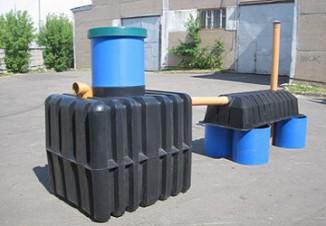
Connection of autonomous sewer pipes for a country house
When it comes to connecting sewer pipes, you should use special knee, and in addition, tees are used. The latter are used with rubber cuffs. Before connecting the pipes, you should lubricate their ends with silicone sealant. In those places where the pipes cross the wall, it is necessary to install sleeves. Then you need to install the riser.
Slope of autonomous sewer pipes
The installation of the pipeline must be carried out in accordance with a certain slope. Its value largely depends on the diameter of the pipes used. If 50 mm pipes are used to create an autonomous sewer system, then the slope should be 3 cm per meter.
Exhaust system
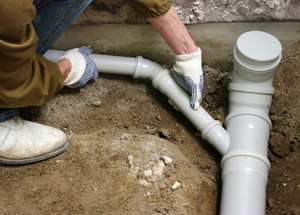 The pipe leaving the house must be connected to a pipeline located outside. This is the place called a sewer outlet. It should be installed under the foundation below ground level to eliminate the possibility of the pipe freezing in winter time. A hole should be drilled in the foundation and a pipe should be inserted, which will then be covered with a special sleeve that can ensure the installation of the appropriate slope for the pipeline. You should know that the larger the outlet in the plumbing, the closer it should be installed to the riser. Be sure to install a toilet nearby.
The pipe leaving the house must be connected to a pipeline located outside. This is the place called a sewer outlet. It should be installed under the foundation below ground level to eliminate the possibility of the pipe freezing in winter time. A hole should be drilled in the foundation and a pipe should be inserted, which will then be covered with a special sleeve that can ensure the installation of the appropriate slope for the pipeline. You should know that the larger the outlet in the plumbing, the closer it should be installed to the riser. Be sure to install a toilet nearby.
Installing a riser in a country house with your own hands
The best place to install a riser is the toilet. During operation, slanting tees should be used to securely connect the riser pipes. Tees can also be used to connect devices of different diameters. Products are used as a collector pipe diameter 110 mm. It is installed at the intersection of pipes from the bathroom, shower, and washbasin. As an additional measure, it is necessary to install a water seal, which will eliminate the occurrence of unpleasant odors and also help avoid clogging during operation of the sewer system.
Fan pipe
When installing an autonomous sewer system for country house A drain pipe must be installed. Through it, gases that collect in the sewer will be removed. In addition, it will ensure ventilation of the pipeline. Its presence as part of an autonomous sewer system will increase the service life of the system, due to the fact that such a pipe provides pressure regulation. The pipe is connected to the riser, which is located in the toilet. The pipe itself leads to the attic.
When purchasing a private house or its self-construction you need to pay attention to the installation of an autonomous sewage system. This system- this is the main question that worries the owners of cottages and houses, because sewage must be discharged somewhere, since its presence will be constant.
Without sewerage, it will be impossible to operate the toilet, bathroom, kitchen, as well as household appliances in the form of a washing machine and dishwasher.
Autonomous sewerage is an independent system, for example, from energy sources, since its operation is based on the laws of physics. Liquid will flow from higher points to lower ones, relative to the surface of the earth.
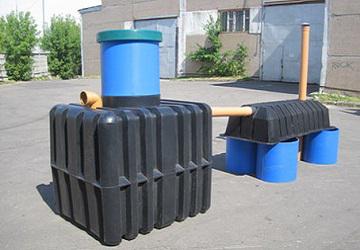
Thanks to this, such a system can be made in any large country house or in a small country house. In addition, its advantages also include:
- minimum cost of maintenance;
- easy operation;
- the ability to install the system on any terrain.
Autonomous sewerage can be made in the form of a regular sewage system or a treatment system. It is necessary to remember that the septic tank will have to be cleaned from time to time.
To do this you need to call a sewer truck., which pumps out sewage using a vacuum. The treatment system is a modern structure that consists of three tanks. You can make such a line yourself, or you can purchase this equipment on the market.
Currently, septic tanks are installed only on land plots near country houses, where people plan to live for a short period of time during the season.
If you plan to use the sewerage constantly - around the clock and all year round, then it is better to give preference to a treatment facility. The standard autonomous sewer system consists of three tanks in which wastewater is accumulated, purified and settled or filtered. This system must perform the following functions:
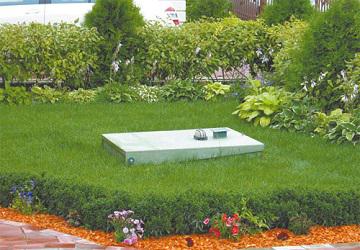
- collection of wastewater from water intakes in the bathroom and kitchen;
- transfer of wastewater from the house to a storage or treatment device;
- purification of sewage and storage for subsequent disposal.
The components of this system include:
- internal communication networks and plumbing;
- external communication lines;
- cleaning devices and filtration.
The principle of operation of a sewer line in a private house
Internal communication networks consist of water inlets and pipes that are located inside the house. Water intakes include: toilet, sinks in the bathroom and kitchen, washing and dishwasher and so on.

Networks of external communication lines include pipes through which water will flow from water intakes to the treatment plant. These structures should include a septic tank consisting of several chambers or another treatment device.
When a septic tank is used, then it is necessary to do additional filtration, which will perform additional treatment of sewage after the septic tank, if it is not planned to pump it out.
The operating principle of the autonomous system is very simple and consists of biological treatment. Domestic wastewater contains organic compounds that contain aerobic microorganisms. They produce biochemical destruction of organic matter in wastewater, and forced air supply helps speed up the process.
Due to this, the contents in the aeration tank are oxidized, waste water become transparent and remove impurities.
The entire cleansing process can be divided into the following stages:
- the entry of sewage into the first compartment;
- preliminary biological purification;
- pumping wastewater into an aeration tank, into which oxygen is supplied;
- additional oxidative process;
- final purification of dirty water from impurities with the formation of activated sludge (a product of bacterial life);
- the flow of water into the third compartment, in which the sludge and water will settle.
This type of complete wastewater treatment cycle meets international standards. There is no contact of wastewater with the environment, since the entire process takes place inside the structure.
Scheme of autonomous sewerage in a private house
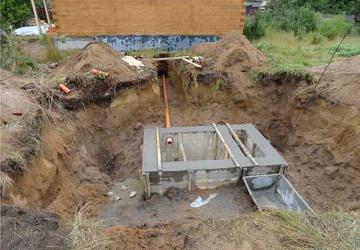
As mentioned above, it consists of internal systems and external communication lines. To this diagram three tanks need to be added, in which wastewater treatment occurs.
To draw up a drawing correctly, you need to start with internal communications. Count all consumers who use water in the bathroom and kitchen. The outside line consists of pipes that carry wastewater from the house to the first treatment tank.
The diagram is needed so that you can calculate the number of pipes needed to equip the system. It is better to make a drawing in advance showing the location of the tanks and the location of the pipes.
Calculation of approximate costs. How much does a homemade system cost?
In order to make such a line for wastewater treatment, you will need three concrete rings. The cost of one such product varies from 1500 to 2000 rubles. Therefore, it will take about 6,000 rubles to create the reservoirs.
You will also need sewer pipes that are connected from the house to the treatment plant. Depending on the length of the pipes (the cost of one meter is from 200 to 250 rubles), you will have to pay from 3,000 to 5,000 rubles. The further away the wastewater storage barrels are located, the more pipes will be needed.
It is necessary to prepare about 10,000 rubles to create such a system.
It is worth noting that there are factory-made treatment plants consisting of three compartments. Their cost ranges from 60 to 200 thousand rubles. Therefore, making this type of sewage system yourself is much cheaper.
How to make an autonomous sewer system with your own hands?
Installation of autonomous or local sewerage, whether it is a single tank in the form of a septic tank that needs to be constantly pumped out, a do-it-yourself treatment plant or a factory system for treating wastewater is not particularly complicated. It is produced using the following steps:
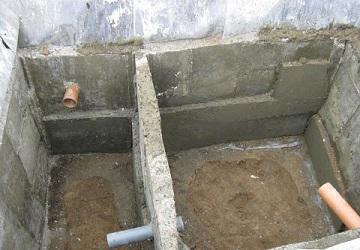
- First you need to create a project or draw a drawing in the form of a plan on the area where the system elements will be located. If the house is only at the construction stage, then you need to choose a place for a pit with dimensions depending on the dimensions of the station or septic tank.
- After this, it is necessary to dig a hole under the pipe, which plays the role of supplying wastewater to the tank. Such a pipe is usually up to 110 centimeters long.
- The depth of the pit should be no more than 50 centimeters and with a slope of up to 5%. The pipe must be additionally insulated.
- At the next stage, the sewer can be installed by lowering the station into the hole and connecting all the pipes.
Some owners of private houses use additional equipment for the operation of autonomous sewerage. Such equipment may include, for example, a pump, which is used to ensure good operation of the pipeline, preventing blockages.
If you install a pump, then you need to supply power to it. In this case, you need to do a test run of the system before instillation. After installing the treatment plant, it is necessary to pay attention to the improvement of the site.
The area of land that was used for the installation of tanks and pipes must be planted with grass and the hatches covered with stones.
Autonomous sewerage in a private house can be of different types. You need to choose depending on the purpose of the house (country house or individual house for year-round residence) and the number of people living in the house.
From this video you can learn how to make an autonomous sewer system and its operating principle:
The operating principle of a septic tank is simpler compared to a sewage treatment system. Sewage from the septic tank must be pumped out, and in a structure with three reservoirs, water purification occurs using biological processes.
But how much does such a design cost? If you make the structure yourself, it will cost much less than a system from the manufacturer. It is very simple to create a septic tank or wastewater treatment system with your own hands. You need to buy everything in advance necessary materials and dig a hole of the required size and depth. The parameters of the pit depend on the size of the septic tank or treatment system tanks.
To ensure that life in a private house does not resemble camping conditions, it is necessary not only to supply water, but also to ensure the removal of wastewater. There are several types of sewer systems, which allows you to choose for a particular area the option that is most suitable in terms of cost, method of operation, and capabilities. In this article we will talk about autonomous sewerage and its types.
The simplest type country sewer. To make cesspools:
- You don't need to spend a lot of money.
- It won't take much time.
- You can use any available material for construction.
This is where all the advantages end. But there are a number of disadvantages, and quite significant ones:
- The presence of an unpleasant odor.
- There is a possibility that not only soil but also water may become polluted.
- It is necessary to frequently call a sanitation specialist to clean the system, which is associated with high costs.
- In winter, the pit can freeze very deeply, which prevents the treatment of wastewater, and therefore the ability to use it.
Many owners of private plots, in order to facilitate the maintenance of the cesspool, make it without installing a special bottom that filters the drains. Unfortunately, such tricks are punishable, since a number of laws prohibit the use of cesspools without a bottom.
Moreover, the use of cesspools is unacceptable if their volume is filled by 1 cubic meter or more.
If you still decide to choose the construction of a cesspool, you need to make a pillow at the bottom:
- The first layer is coarse sand.
- The second layer is crushed stone.
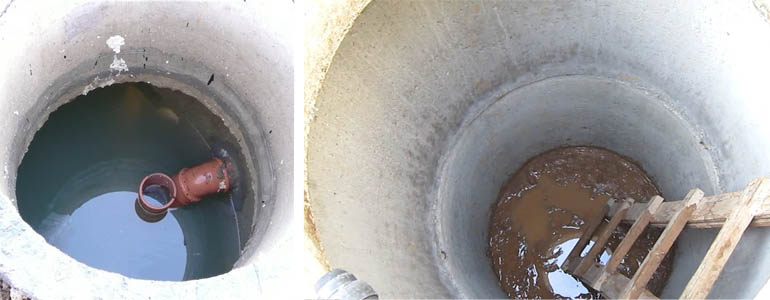 Cesspool using concrete rings provides increased strength and tightness of the structure.
Cesspool using concrete rings provides increased strength and tightness of the structure. Dry toilet
This is the name given to the design with a plastic container. Consists of a cabin and two tanks. At the top there is a container with clean water for flushing the toilet, and at the bottom under the booth there is a container for waste. There they are cleansed.
Dry toilets can be purchased as portable or stationary, which allows you to choose the system that is most suitable.
In this video, Elena Malysheva advises how to choose a dry toilet:
In a stationary dry closet, sewage is cleaned with organic or chemicals. The system can be installed both inside the house and outside. Both options have their drawbacks: a structure located in the house will very soon make itself felt with unpleasant odors, and one installed outside may collapse in the winter, since it is not designed to withstand the weight of snow or ice.
Advantages of dry toilets:
- Compactness.
- Mobility.
- Easy to care for.
- Low cost.
- Long working time.
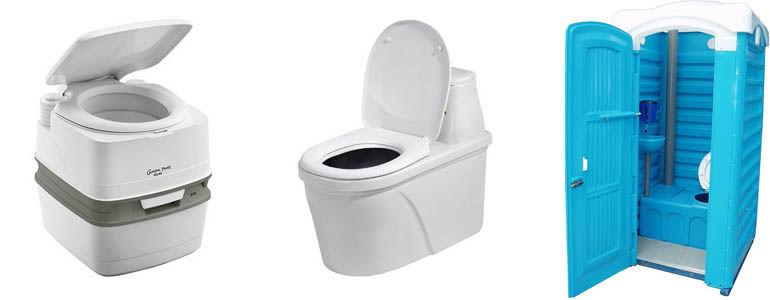
This type of system is one of the most reliable, efficient and affordable. Thanks to their use, you can clean drains and eliminate any unpleasant odors.
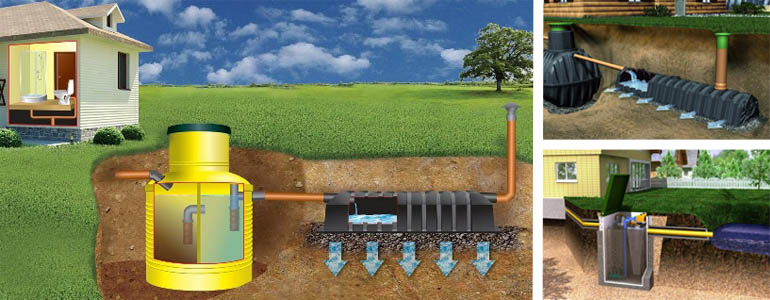
Advantages of autonomous sewerage:
- Compact dimensions.
- Safety.
- High tightness.
- Possibility to install on a site with any type of soil.
- Duration of operation - sewerage can operate effectively for over 20 years.
But the most important thing: the presence of an autonomous sewer system allows you to install a shower and everything that is necessary for a comfortable life in a private house. We are talking about dishwasher and washing machine, toilets, bidets and other achievements of civilization.
If you plan to install an autonomous sewer system, you must remember that you will need to lay a large number of communications. If work is carried out in a new house during its construction, the work will not be so difficult. If the sewerage system is installed in a habitable private house, you will need to drill the walls and remove the floors in the required areas. Therefore, if possible, it is best (and cheaper) to make a sewer network during the construction of the building itself.
In this video watch about various types autonomous sewerage devices:
Types of systems
Waste recycling can be carried out
- Soil filtration.
- Deep biological treatment.
Soil filtration
If the use of soil filtration is expected, multi-chamber septic tanks are used. Moving through the chambers, the wastewater is cleared of solid waste, which decomposes almost completely, for which anaerobic bacteria are used. The purified water then enters a filtration well or field where underground filtration takes place.
Advantages:
- Low cost.
- Minimum maintenance costs.
- Durability.
Flaw: Untreated wastewater may end up in groundwater.
Biological treatment
A monoblock and other equipment are used for biological treatment. This is a control unit, pump, compressor. In order for anaerobic bacteria to process wastewater faster, the compressor supplies air masses. The treated waste and sludge are pumped over.
Advantages of the method:
- Compactness.
- No need for a vacuum cleaner.
- Excellent wastewater treatment.
Flaws:
- Electricity consumption.
- Maintenance required.
- To maintain the station, you will need to spend money.
- It is necessary to ensure that no aggressive chemicals enter the system, which can kill bacteria.
Operating principle
An autonomous station, designed for a private home, combines a cleaning process in which naturally occurring air and microorganisms act on the wastewater. Under this influence, wastewater components are oxidized. Or rather, the microorganism destroys organic substances. The remaining wastewater can no longer rot; over time, it is cleaned and becomes transparent.
After aeration cleaning, the output can be water intended for technical purposes. The best organic fertilizer there will be the resulting sludge.
Sewage device
Since the manufacture of an autonomous network is a complex technical task, preliminary calculations must be made taking into account the following indicators:
- Soil structures.
- The relief of the site and its size.
- Number of permanent residents.
- The depth to which groundwater lies.
- Soil freezing depth.
When calculating, it is necessary to include a reserve of sewerage productivity. The perspective can be from 10 to 15-20% of the total system volume.
Options for autonomous sewerage for a home where there is large number stocks:
- Biopurification system.
- Storage tank with filtration field.
- Storage tank with filtration well.
- Storage plastic or metal container.
The choice of option is influenced by the geological structure of the soil. It also matters how large the volume of household waste is. For example, if there are artesian wells nearby, it is impossible to build a system with filtration wells or a field in accordance with the relevant Law of the Russian Federation.
Selecting a waste container
Containers where wastewater will be collected can be built from existing available materials (for example, stone, brick) or purchased ready-made. Among all the materials that can be used by manufacturers to make containers, plastic products are considered the most popular and most suitable. This became possible thanks to the many advantages that plastic has:
- Durability.
- Strength.
- Ease.
- Resistant to rot and rust.
- Possibility of installation without the use of expensive special vehicles.
- There is no need to install waterproofing.
- Availability of tanks of different volumes and shapes - round, oval, square, rectangular. Since it is easiest to make a hole for a container in a round shape, round containers are purchased most often.
There are also disadvantages. These include:
- High price. But this indicator cannot be considered a disadvantage, since during operation the money spent will be fully recouped.
- To prevent sewage from overflowing, it is necessary to equip the container with a filling sensor.
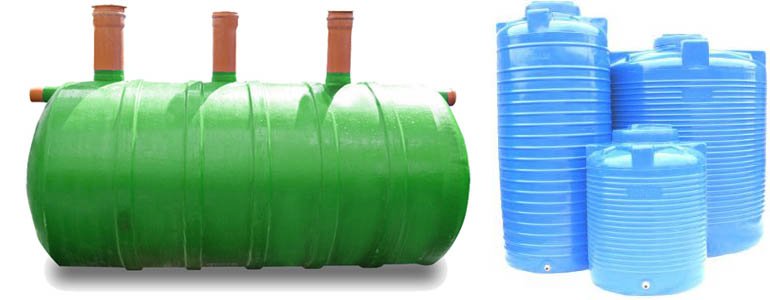
Features of manufacturing systems
Internal sewerage
Sewage pipes located inside the house have horizontal and vertical sections. In order for the sewage system to work smoothly and to avoid blockages, it is necessary to purchase pipes for risers with a minimum diameter of 10 cm. All horizontal sections must be located at a slope of 3 cm at every meter.
The best material for making a pipeline is plastic. It is least likely to cause blockages. In addition, this material is durable, lightweight, durable and inexpensive.
External networks
For the construction of private external networks, you can choose any material, so you can use pipes from:
- Polyethylene.
- Polypropylene.
- Polyvinyl chloride.
- Cast iron.
- Steel.
- Asbestos cement.
Since pipes are laid to storage areas, they also need to be laid at a slope. The level of laying external pipes should be located below the level to which the soil freezes. If this is not possible, then the pipeline must be insulated from foam freezing
Today, there is a certain type of domestic sewage system that uses special means for recycling waste. Let's consider the main and fundamental factors, as well as the types, types and criteria of various autonomous sewers. This alternative is quite attractive for people who have private houses or summer cottages.
Unlike a cesspool, autonomous sewerage is involved in the production of purification, but not in any way in the accumulation of wastewater. There are several cleaning methods available, divided into three main types: chemical, biological and mechanical.
The use of special substances that cause cohesion of particles (coagulants) - chemical cleaning. Organic substances are extracted with the help of microorganisms - biological treatment. Physical and mechanical methods that help remove insoluble impurities - mechanical cleaning.
There are two main types of treatment facilities, based on the scheme used - septic tanks, which have underground filtration facilities and some pre-fabricated (biological) treatment plants.
The need for autonomous sewerage is no longer worth proving at present. latest technologies and scientific progress. If it is not possible to connect to the central sewerage system, there is an alternative - a local independent system. It is needed for the storage and disposal of wastewater.
For a private home, such a system is a tank that is intended for temporary storage. Or is it a treatment plant system consisting of a septic tank and filter units. This installation performs its functions for quite a long time and does not depend on external factors. The presence of electricity, sewage removal or connection to the central sewerage system does not matter in this case.
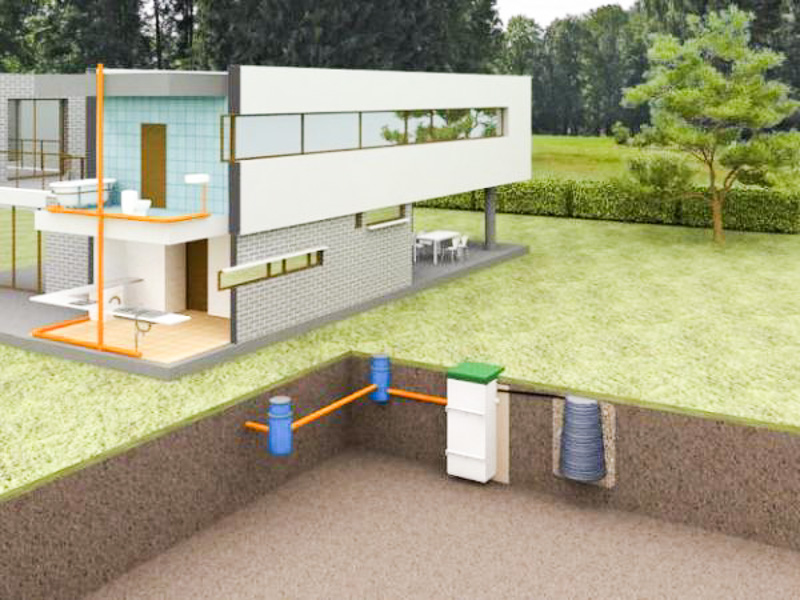
Main types of autonomous sewerage
cesspool
cesspool- a ring of concrete or other storage tank where wastewater will be collected. The main and very pressing question when building a house is where and how to equip this structure. In the city, no one even thinks about this, but the private sector has its own everyday inconveniences and difficulties in this regard.
This problem comes to the fore; in order for people to live cozy and comfortable, the sewer system needs to function without failures or problems. The device itself is quite simple and, with the right approach and quality materials, will last a long time.
An important detail that must always be taken into account is choosing the correct volume of the pit itself so that there are no problems with cleaning in the future. Select a place that will meet all the parameters and measurements, and after all this, begin to equip it. It’s not easy that the cesspool should not be placed near the house. Although very long sewer pipes will also be quite undesirable. In order for a sewage disposal truck to be able to drive up to the pit without obstacles, there must be a clear and convenient access.
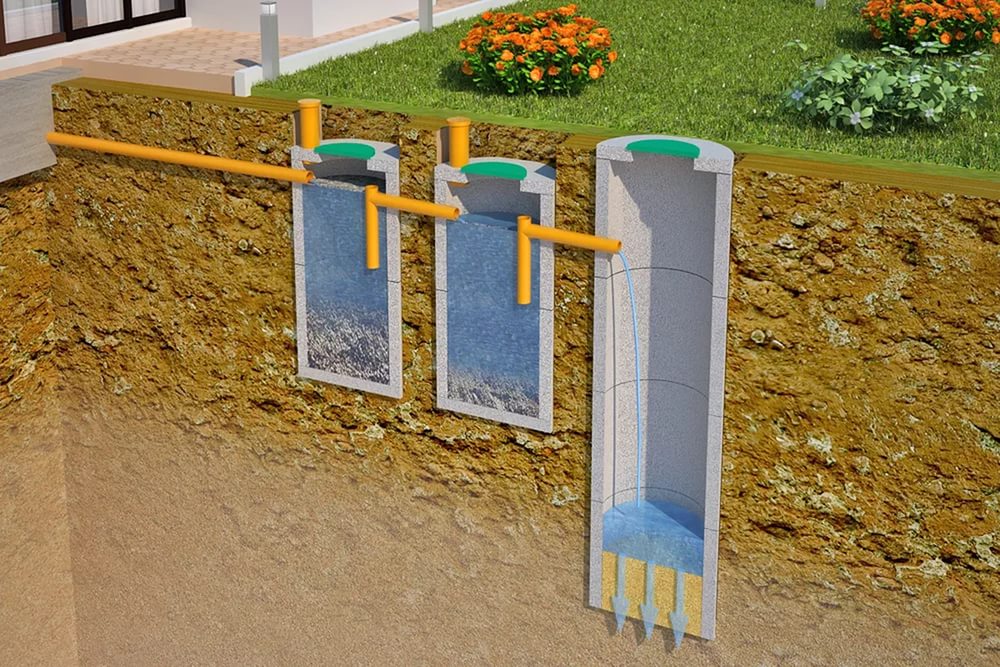
There are certain systems and rules for the location of the pit itself, its distance to various other objects on the sites. Basic requirements:
- the distance from the house to the pit is from 5 m;
- 1m from the bottom to groundwater;
- 1m from the fence to the edge of the pit;
- to sources drinking water(clay – 20m, loam – 30m, sandy loam – 50m).
The long service life of this structure depends on the required volume. When calculating per person, 0.5 cubic meters. If there is such a possibility, you can provide a device with a small reserve in volume. As an example, if three people live in a house, it will be about 6 cubic meters.
When the volumes have already been determined, the next step is to lay the pipes. With the required slope, about two or three percent (two, three cm) falls on each linear meter of pipe. Accordingly, if the pipes are longer, the slope decreases.
There are two types of cesspool design: without a bottom and sealed (plastic container or other) buried in the ground. Construction technologies depend on the soil, the number of people living in the house and the location of groundwater. If this is a dacha and all year round they won’t live there, then you need to make a hole like a container with a filter bottom. It looks like a well if the wastewater is no more than one cubic meter per day.
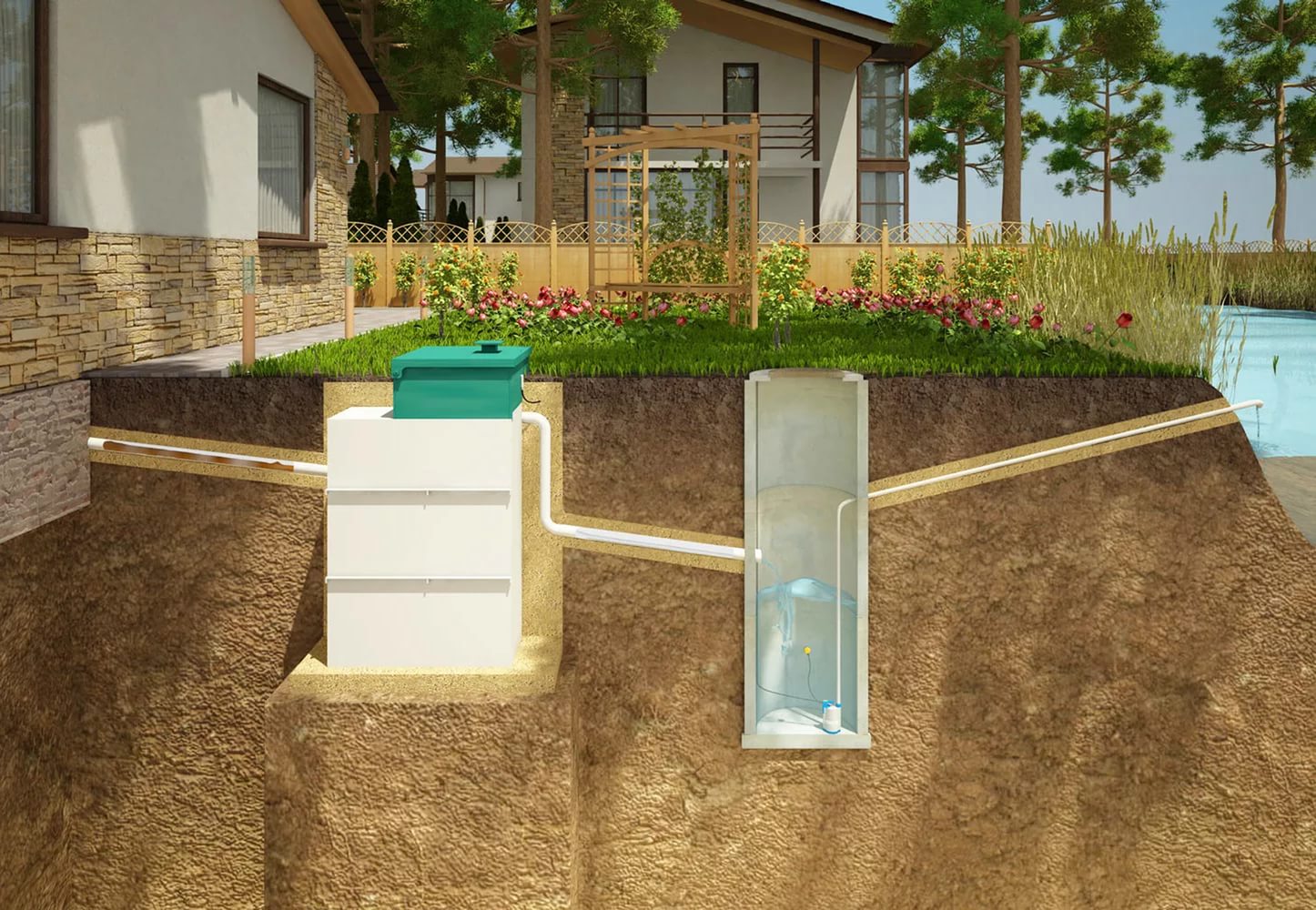
There are some stages in constructing such a pit:
- simultaneous construction of walls and pipe laying;
- leave one and a half cubic meters of soil during digging for thermal insulation;
- lay a pipe inside the well above the second ring from the surface;
- installation of hatches occurs after installed pipes, rings and covers;
- thirty cm width of the trench at the level of the walls;
- The slab is covered with soil and the hatch is left free.
Septic tank
Septic tank– a closed autonomous system, when wastewater enters it, mechanical filtration occurs with the help of bacteria. Almost ninety-eight percent, achieving the cleaning efficiency of such a system. Therefore, such wastewater is discharged and absorbed into the ground without the risk of contamination of both groundwater and the environment.
The tightness of the system prevents the penetration of unpleasant odors that are associated with removal and cleaning. In the private sector, at dachas and sanatoriums, you can very often find such systems. There are many advantages in this installation - cost-effectiveness, ease of maintenance and efficiency at the highest level.
The basic principles of operation of a septic tank are the settling of wastewater and the mutual action of the liquid with anaerobic bacteria. Today there are a lot of different septic tanks and the most popular autonomous models. There is no need for any energy sources, additional installations or special conditions.
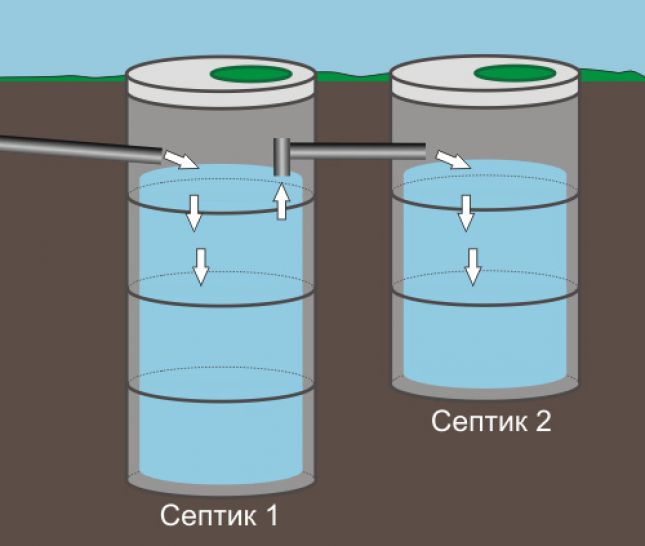
The range includes plastic containers with partitions inside for a sump and biofilter. The simplicity and reliability of this design attracts buyers. Polypropylene is of high quality and thick, a good solution and quite a budget option.
The advantages of this design:
- convenience (block-modular);
- efficiency with infiltrator;
- compact size, simple installation;
- availability and reliability;
- ease of maintenance (pumping once a year).
The durability of the device, the capacity and separation of the chambers themselves for some processes of settling and biological decomposition. The operating principle of a septic tank includes several processes. The receiving chamber where wastewater enters is quite large. Inorganic substances that cannot be decomposed are deposited here. The second settling tank receives clarified water for better settling.
The third chamber is equipped with a biofilter in the form of a cyclone, where waste products of microorganisms accumulate and organic matter decomposes. All cleaning processes proceed consistently, efficiently and efficiently. To carry out soil purification of water from contents harmful substances, the installation is connected to the infiltrator.
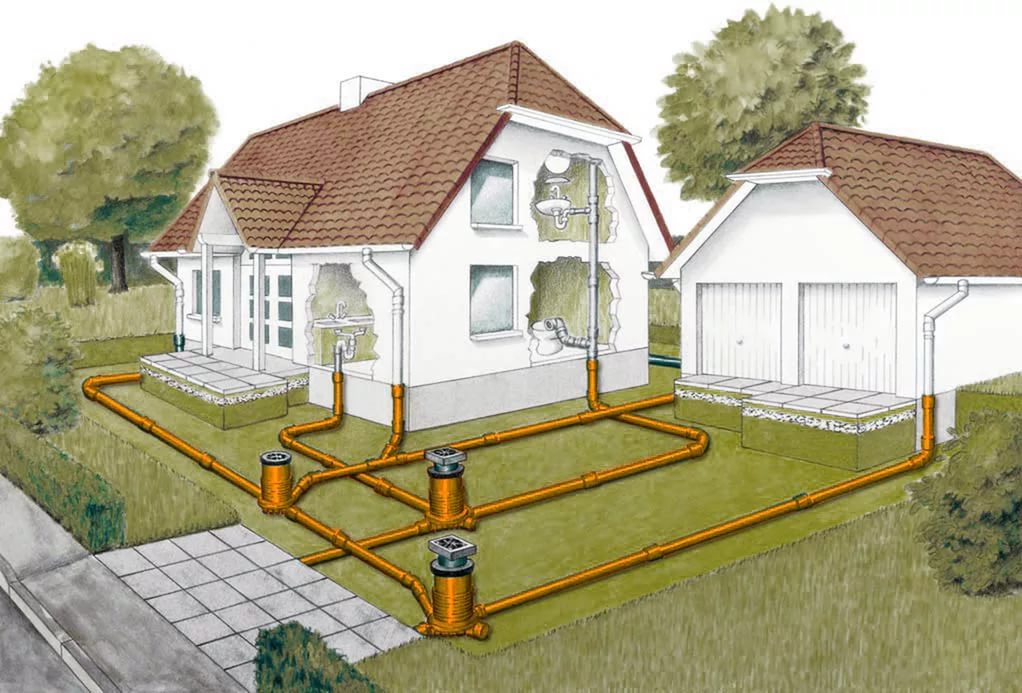
Installation of a septic tank, brief information:
- large-scale excavation robots (installation pits, pipeline trenches);
- leveling the surface with sand, strengthening the bottom;
- a 400 mm gravel layer for the infiltrator;
- sand thickness for trenches 200-300mm;
- connecting pipes, filling with water for strength;
- sand-cement mixture for filling on the sides of the installation.
There are septic tanks affordable prices, especially when compared with the cost of other manufacturers. The competitiveness of the product speaks for itself, for example, Tank septic tanks. Can meet the requirements of many buyers with maximum efficiency.
It is important to know that septic tanks will be immediately ready for use and installing them yourself is quite realistic and possible. The approximate price scale for such treatment plants as “Tank 1, 2, 3, 4” is given in this table:
|
Name |
Number of people |
Performance |
Dimensions, mm |
Price, rubles |
| Tank 1 | 1-3 | 600 | 1200x1000x1700 | 28000 |
| Tank 2 | 3-4 | 800 | 1800x1200x1700 | 38000 |
| Tank 3 | 4-6 | 1200 | 2200x1200x2000 | 55000 |
| Tank 4 | 7-9 | 1800 | 3800x1000x1700 | 68000 |
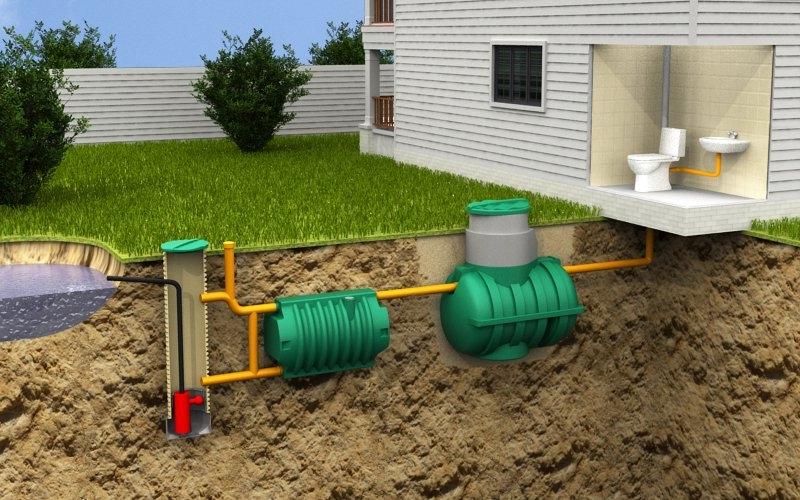
Now many people have begun to think about environment, its preservation for future generations. The owner of a private house or country plot strives to live in comfort and away from civilization. Without the necessary communications, you can make life comfortable and convenient for the whole family, while preserving nature.
More recently, adjoining houses have appeared wastewater treatment plants, but at the moment they are already very popular and in demand. Another representative of the treatment station is the septic tank " Topas", which is produced by the Topol-Eco group of companies. This is local biological system wastewater treatment, which has the principle of preliminary sedimentation of large suspended matter.
Let's consider some principles of operation of this septic tank
The first chamber serves for sedimentation, the wastewater flows through a central outer pipe from the household sanitary equipment. At the first stage, the process of biological decomposition is already underway due to the supply of oxygen. The settled water from the reservoir, using the airlift, passes into the second compartment.
The aeration tank is the next reservoir in which the main work of activated sludge occurs. Due to the respiration process of microorganisms, pollutants are decomposed and air is supplied by the compressor. The particles become overgrown with silt, and this allows them to be removed during the sedimentation process in the next chamber.
Sump – third compartment, pyramid. It precipitates sludge from the water and removes already purified water. The liquid leaving the secondary settling tank must pass through an additional filter.
One hundred percent purified wastewater is discharged into a receiving container (ditches, reservoirs). Thanks to high level purification, such water can be used for watering various plants, shrubs, trees and other plantings.
From the secondary settling tank, light suspended sludge is fed to the beginning of the cycle, and the fourth chamber for heavy sludge is called a stabilizer. The scheme is quite simple and without human intervention, it is possible to obtain high-quality wastewater treatment. The basis is ordinary natural processes biological decomposition.
There is a slight drawback to the Topas septic tank and this is its energy dependence (compressor operation). But there are many more advantages:
- compact design;
- electricity (low consumption);
- installation diagrams are simple;
- the operational process is not complicated;
- The model line is large.
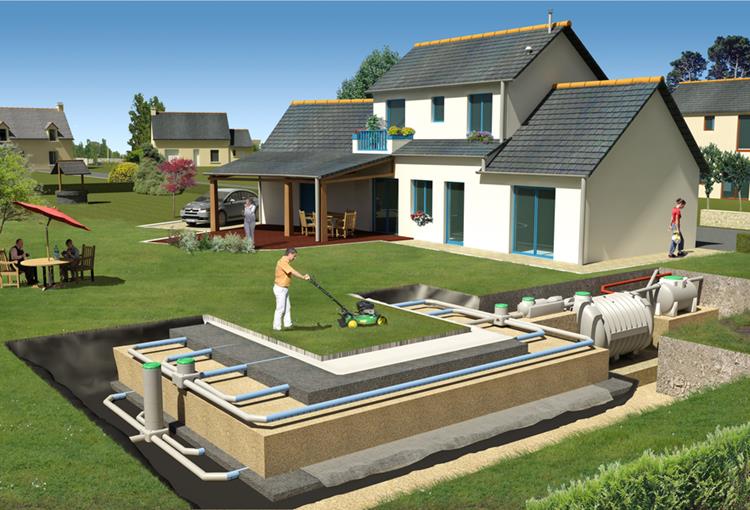
These models of such septic tanks differ in capacity; it depends on the number of people operating the sanitary equipment of a residential building. If the house has a large sanitary equipment, then you need to buy a septic tank with increased productivity.
Each such model provides for two main modifications: standard (pipe insertion to a depth of 0.3 - 0.9 m) and long (1.0 - 1.5 m). Also available with an equipped pump, another modification, where the output of purified water is forced.
Maintenance and operation rules
Start-up work is carried out immediately after installing all elements of the Topas cleaning system, and for the first time it is better to do this by a specialist in this field. The required biomass is formed in about three weeks. To speed up this process, sludge from the reservoir should be added.
Necessary actions during routine maintenance:
- cleaning compressor membranes (every two or three years);
- replacement of aeration equipment (every twelve years);
- year-round use of a septic tank (every three or four months, removal of waste sludge);
- comprehensive station maintenance (every or two years).
When all procedures are completed, reinstall the equipment and fill the septic tank two-thirds with water. Now you can begin further use of this device. Otherwise, the Topas septic tank works efficiently and in autonomous mode.
The choice is always yours, but if you are not a builder and do not have skills in this area, it will be better to contact a specialist this issue. The conditions of your area, drainage volumes, and correct calculations according to all building codes are important. Climatic conditions, relief, soil characteristics and the location of underwater waters and many other factors also play a fundamental role. Therefore, it is up to you, weigh and consider all the arguments and make the right decision for you and your family.
Calculate the cost of your renovation! For free!
By filling out the form and clicking the “Continue” button, our specialists will calculate the approximate cost of the work and, if you need it, will suggest good specialists.
At the moment, calculations are made only for residents of Moscow, Moscow region, St. Petersburg and Leningrad region:

Live in your own country house many would like to. Clean air, silence, large personal space and the absence of neighbors above and below are all attractive. When we talk about how great it is to move out of town, we mean that the housing will be comfortable, with everything a modern person is used to.
Drainage systems Not all villages have them, so you often have to solve the problem of sewerage installation yourself. This question is also relevant for summer residents who would like to spend more time in nature, but are not ready for semi-wild living conditions.
I already wrote about that. Today I’ll tell you how to choose the right autonomous sewer for a private house, its structure, layout and installation depth.
What to choose for sewerage of a country house?
Create an autonomous sewer system can be done in several ways:
cesspool
A cesspool, that is, a plank house in the backyard according to an old design. Not best way, suitable only for a summer house where you spend your weekends.
VOC
Local treatment plant (LOS). If you intend to live in a country house permanently, VOC is exactly what you need.
Storage capacity.
Sealed sump
A sealed septic tank in which wastewater accumulates. To clean the containers, you need to periodically call the vacuum cleaners. This option is suitable for a small family. At the dacha, this toilet option is also quite acceptable, especially if you come only for the weekend.
Sewage does not pollute the soil, but you will have to spend money on sewerage maintenance (calling sewer trucks).
Septic tank
The wastewater is cleaned mechanically and enters a filtration well. Such an autonomous sewage system requires maintenance, but not as often as with storage tanks. And once every 5 years it is necessary to pump out solid fractions.
How to choose an autonomous sewer system in a private house?
I have listed main components of an autonomous sewerage system. When planning, you must take into account specific conditions:
- Relief.
- Climate.
- Soil features.
- Location of groundwater.
- Number of people living in the house. If we are talking about a house where you are going to live permanently, the load must be calculated according to existing water consumption standards.
- Possibility of access to the house. The vacuum truck must drive directly to the site to pump out the sewage.
- To lay a sewer system in a country house, it is necessary to develop a project.
If you are not a builder, it is better to contact specialists who will take into account the conditions of a specific area, drainage volumes and make calculations according to building codes.
To the sewer system for a private home includes:
- Pipeline inside the house or internal sewerage network.
- External piping to a treatment or collection plant. External sewerage must be laid on a slope for gravity drainage
- Storage or treatment facilities (reservoir, septic tank, filtration fields).
Device and laying depth sewerage in a private house is clearly demonstrated by the diagram below:

Since the cesspool local treatment station and sealed septic tank are more suitable for sewerage country house, I propose to consider the further design and principle of operation of a sewer system for a private house using the example of a septic tank.
Septic tanks - arguments for and against
I have already told you in detail about where I cited real prices and customer reviews. So, after analyzing the information about this type of autonomous sewage system, I came to the conclusion that mechanical wastewater treatment, although it has obvious advantages, is not without its drawbacks.
The undoubted advantages of septic tanks
- Energy independence. A septic tank does not require electricity to operate.
- Does not require maintenance.
- The functionality of the septic tank is not affected by climate and weather conditions.
- During interruptions in the operation of the sewer system, its operation does not deteriorate.
Pros and cons of septic tanks
- Possibility of unpleasant odor.
- Construction requires a fairly large plot of land.
- From time to time you have to call a septic tank to service the septic tank.
- Certain geological conditions are required, in particular low groundwater levels and light soils.
How much waste can you expect?
In accordance with building regulations, per person living in the house accounts for 200 liters of wastewater per day. Based on this, they calculate the volume of the septic tank, which should accommodate wastewater for three days.
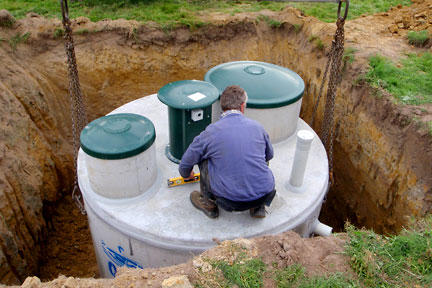
If your family consists of five people, you need to install a septic tank with a volume of at least three cubic meters, since the daily volume of wastewater is 1,000 liters.
Construction and scheme of sewerage from a septic tank
Before you begin installation The septic tank follows the fate that the pipes must be at a depth of at least 60 cm, and the distance to the first inspection well is up to 12 meters (hereinafter - every 15 meters). If there are places on the site with a significant difference in height, intermediate wells are installed. It is advisable to have a well at every turn of the pipe.
The best time to install a septic tank is considered to be summer and autumn, although if the groundwater level is low, work can be carried out at any time.
Basic rules for installing a septic tank
- The pit for installation must be deep enough to accommodate a gravel cushion (20-30 cm), a base for fastening (concrete slab or pour), the septic tank itself and a covering layer.
- Leave the lid of the septic tank on the surface of the ground so that rainwater does not get inside. For the winter, cover the lid with thermal insulation material.
- Place the septic tank no closer than 6 meters from the house, otherwise the water going into the ground will flood the basement and damage the foundation.
The price for a turnkey installation of an autonomous sewage system from a septic tank in a private house ranges from 50 to 105 thousand rubles. The cost depends on the brand of equipment and the company’s tariff.
Sewage pumps in a private house
If possible drain wastewater by gravity through a pipe laid at an angle to the septic tank; an autonomous sewage system will work without additional equipment. However, in some cases a special pump is still required - drainage or fecal. This different types pumps that differ in design and purpose.
Types of pumps
- Drainage pumps for sewerage in a private house they are used if you need to pump out water from a basement or sump. This pump is suitable for draining water without large solid fragments (from a washing machine or dishwasher).
- Fecal pump Designed for wastewater with solid contaminants. Some models of such pumps have expanded drain channels, others are equipped with grinders. There are pump options for pumping out hot and cold waste.
We will consider the second type of pumps, which are divided into:
- External, which are installed above sewer well, lowering intake hoses into the wastewater.
- Submersible. They work directly in the drain. Horizontal submersible pumps operate at depths of up to 100 m, vertical – up to 7 m.
- Semi-submersible. The pump motor remains on the surface, the pump part is submerged. This modification is not suitable for sewage - it does not have grinders.
Which pump to choose?
For a private home fits submersible pump. There are several models on sale, differing in price, material, impeller structure, and power.
- The best materials for sewerage there will be plastic, stainless steel and cast iron.
- Chopper (impeller). Better knives than cutting edges. The best option is a model with a self-cleaning mechanism.
- Power. Choose a pump based on performance criteria, as energy-saving, high-performance models are available. You can save on electricity.
- Pump control. Choose a model without any special bells and whistles.
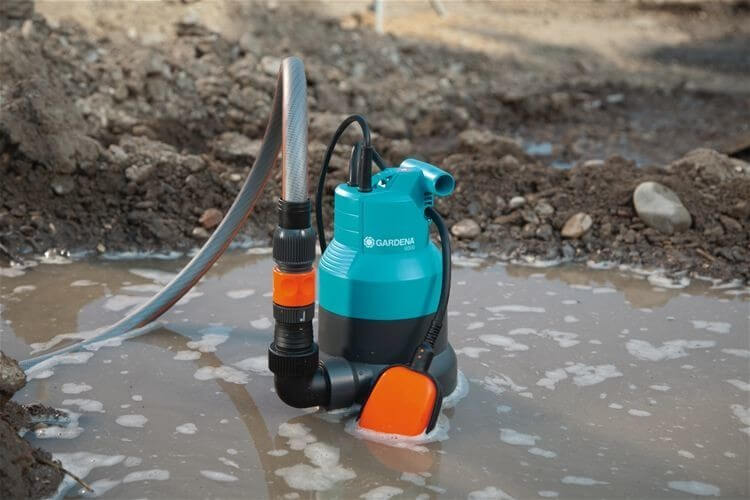
Prices for fecal pumps for sewerage in a private house range from 7-18,000 thousand rubles. For correct installation It's better to invite a specialist.
Some septic tanks have a system. In the first chamber, anaerobic microorganisms work, from where the waste flows into the second chamber, where aerobic bacteria are involved in the cleaning. So, to provide a sufficient amount of oxygen for the life of aerobic bacteria, a compressor is used.
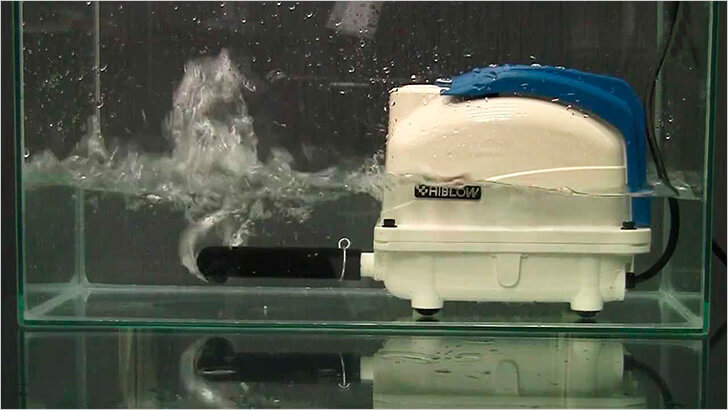
You can buy a compressor for a septic tank from the popular Hiblow brand for 10-12 thousand rubles.
Sewage pipes in a private house
For septic tank and VOC sewer pipes are required, the correct installation of which determines the functionality of the system. The basic rules for laying pipes are as follows:
- Pipes begin to be laid from the treatment plant or septic tank to the internal sewer system, that is, to the house.
- To prevent the pipe from freezing, it should be insulated. To do this, you can put foamed polyethylene on the pipe, and an asbestos-cement pipe on top.
- Pipes are connected by couplings or welding.
- Pipes must be laid at a slope to ensure gravity flow of wastewater.
- To avoid blockages, do not bend the pipe and try to lay the pipeline in a straight line.
- If it is impossible to lay pipes without turning, be sure to install a rotary well.
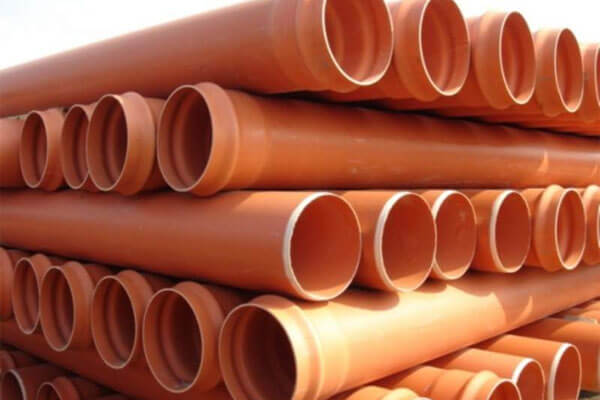
Usually used cast iron (100 mm), PVC or polypropylene pipes(110 mm). Most economical option– pipes and other parts of the pipeline made of PVC. A meter of such a pipe can cost 4,000 or 50,000.